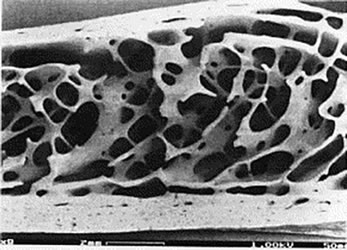Bone is living tissue that performs several important functions. Most obviously, the bones of the skeleton are essential for protection of organs, maintenance of posture, and movement. Less obviously, the bones of the skeleton are essential for the formation of blood cells and the regulation of Calcium levels within the body.
Bone is very strong, but also relatively lightweight. It is made up of microscopic channels that are surrounded by a very strong layer called the Cortex, which in turn is surrounded by a tough outer surface known as the Periosteum. When viewed in cross section the channels produce a honeycomb effect. Apart from making bones lightweight, the channels allow blood flow throughout the bone tissue which supports constant metabolic activity within the bone.

This metabolic activity means that bone is constantly re-modelling itself in response to the stress it is subjected to during exercise and work activities. There are three main types of cell that are active within bone: Bone Cells, Osteoblasts and Osteoclasts. All of these are present within the dense connective tissue of bone called the Bone Matrix. Osteoblasts lay down new bone tissue and then revert to being Bone Cells that sit in the Bone Matrix, whereas Osteoclasts are constantly active, re-absorbing bone tissue. The process of ‘bone modelling’ occurs all the time and this ability to constantly regenerate means that bone can heal fully following a fracture.
Because of the complications that can occur during the fracture healing process it is extremely important that you follow the expert advice of your Orthopaedic Consultant. Any interruption during the stages of bone healing described in this article can lead to a fracture ‘Non Union’ or ‘Delayed Union’, where the fragments come together extremely late or, worse still, don’t come together at all. Your Orthopaedic Consultant will guide you through the stages of fracture healing, which are described in the pages that follow.


